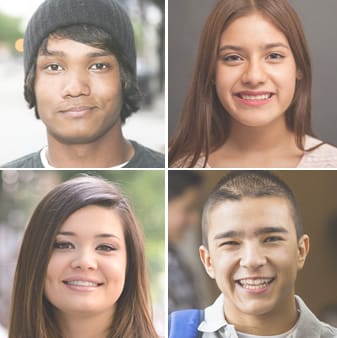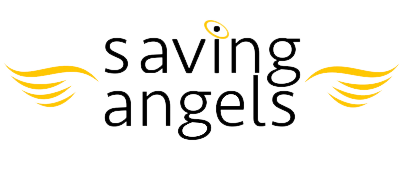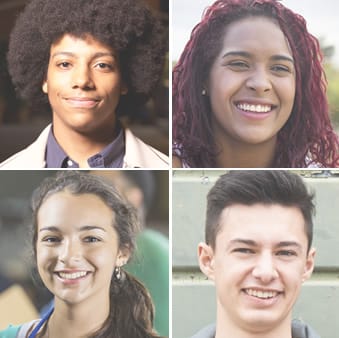How many youth are living on our streets? What dangers do they face? Learn the issues – from foster care to child trafficking
Youth Homelessness
Young people facing homelessness often retreat to the shadows, so getting a sense of the scope of youth homelessness is both challenging and indispensable. Here’s what Saving Angels has learned about children and youth facing homelessness in the countries or regions where we work.
United States
Chapin Hall of the University of Chicago released its first groundbreaking report on youth homelessness in the United States through its Voices of Youth Count (VoYC) initiative in 2017. The VoYC study was conducted over the course of a full year rather than a single night, making it the most comprehensive research to date on youth homelessness in the U.S.
Here is what we learned:
- More than 3.5 million young adults ages 18 to 25 experience a form of homelessness in the course of a year — that’s 1 of every 10 young adults.
- At least 700,000 adolescent minors ages 13 to 17 experience a form of homelessness in the course of a year — that’s 1 of every 30 adolescent minors.
- In total, at least 4.2 million young people experience a form of homelessness in a given year, from couch surfing to living on the streets.
- Half of the youth who experienced homelessness in the past year did so for the first time.
- About 42% experienced two or more episodes of homelessness.
- Youth homelessness affects urban and rural youth at similar levels.
Who is at risk?
- Youth lacking a high school diploma or GED had a 346% higher risk of homelessness than did young people who completed high school.
- Youth in households making less than $24,000 a year had a 162% higher risk of homelessness.
- Unmarried parenting youth had a 200% higher risk of homelessness.
- LGBTQ youth are at more than double the risk of homelessness than their non-LGBTQ peers, and had over twice the rate of early death among all youth experiencing homelessness.
- Black or African American youth had an 83% higher risk of homelessness.
- Hispanic, nonwhite youth had a 33% higher risk of homelessness.
Resources:
Read the groundbreaking Voices of Youth Count: Missed Opportunities series of reports.
- “Youth Homelessness in America: National Estimates,” 2017
- “LGBTQ Youth Homelessness in America,” 2018
- “Pregnant and Parenting Youth Experiencing Homelessness in America,” 2018
- “Counting Youth Experiencing Homelessness in America,” 2018
- “Youth Homelessness in Rural America,” 2018
Homelessness in general increased modestly in the United States in 2018, the second increase in two years. On a single night in 2018, according to the U.S. Department of Housing and Urban Development (HUD), 552,830 people were found to be experiencing homelessness in the United States.
Canada
In Canada, as in the United States, it took a groundbreaking study to shed light on the pervasiveness of youth homelessness. In 2016, researchers at the Canadian Observatory on Homelessness undertook the first pan-Canadian study of young people and wrote up their findings in a report called “Without a Home.”
Here’s what we learned:
- Young people ages 13-24 make up about 20% of the homeless population in Canada. Between 35,000 and 40,000 young people experience homelessness in the course of a year.
- Of the study participants, 40% were under age 16 when they first experienced homelessness.
- More than 75% experienced multiple episodes of homelessness, and more than a third of those youth (37%) had more than five episodes.
Who is at risk?
- LGBTQ2S youth (“2S” Is a Native/First Nations reference to “Two Spirit”) make up 30% of all youth facing homelessness, according to the survey.
- Indigenous youth make up 31% of the young homelessness population.
- Young people who identified as members of racialized communities comprise 28% of homeless youth.
- Young people who were born outside Canada make up 10% of the homeless youth population.
- Youth who first experience homelessness before age 16 are more prone to the greatest hardship, including multiple episodes of homelessness, poorer quality of life, becoming victims of crime, suicide attempts, among others.
Resources
Read “Without a Home: The National Youth Homelessness Survey,” the first pan-Canadian study of young people experiencing homelessness, produced by the Canadian Observatory on Homelessness, 2016.
Central America and Mexico
Acquiring reliable statistics regarding child and youth homelessness in Mexico, Guatemala, Honduras, and Nicaragua, where Saving Angels works in Latin America, is challenging. According to one estimate cited by La Crónica Jalisco (Mexico), some 60 million children and youth across Latin America have nowhere to call home.
Our work in Central America and Mexico began in the 1980s, when civil conflicts left young people extraordinarily vulnerable. Wars ended, but poverty, violence, political corruption, and weak civil institutions in the region remained, and they continue to push young people from their homes.
Here, we’ll look broadly at the children and youth who are most at risk, and at two factors — violence and migration — that are among those that impact youth homelessness in Mexico and Central America. Please visit the other Issues pages and our Casa/La Alianza pages for more information.
Who is at risk?
- LGBTQ youth
- Children and youth raised in poverty
- NiNis, that is children who are neither in school nor working, from the Spanish, “ni en la escuela ni trabajando”
- Street-involved youth with addictions
- Children and youth who experience high levels of family violence
- Children and youth who experience sexual abuse and exploitation
- Pregnant teens and teen moms and their babies
Violence in Central America
- Children and youth are targets of violence in Central America. For eight years in Honduras, from 2008 to 2016, one child died every day by homicide; in Guatemala, 942 children died violently in 2017; 77% of them by firearms.
- Honduras ranks in the top five countries worldwide for homicide rates among adolescents.
- Violent gangs that either formed or festered in the U.S. for years and whose members were deported to Central America in the 1990s regrouped and grew across the region, ruling their territories by intimidation and violence. There are currently at least 7,000 gang members in Honduras alone.
- Central America has become a transit region for illicit drugs from South America to the U.S. market; as much as 90% of cocaine shipments reach U.S. customers through Mexico.
- Homicide is the leading cause of death among adolescents in Latin America and the Caribbean.
Unaccompanied child migrants
- Chronic poverty, violence, relief from critical events such as armed conflict and natural disasters, and the desire for education and job opportunities are strong motivators of migration.
- Families may sell all they have to finance the journey, including paying a “coyote” (smuggler) $15,000 to take an unaccompanied child, with no assurances for the child’s safety.
- In 2016, more than 59,600 unaccompanied minors were apprehended at the U.S. southwest border with Mexico.
- Unaccompanied children and women are at greatest risk on the migration journey, easy prey to traffickers, criminals, organized gangs, security forces, and others who abuse, exploit, or even kill them, according to UNICEF.
- Under its “Zero Tolerance” policy, in April 2018, the U.S. government sought to criminally prosecute adults who entered the country without authorization and separated them from their children. Such a policy leaves children vulnerable to exploitation and abuse and can cause toxic shock, with long-term negative impacts on the children’s development.
Resources:
Read the UNICEF Child Alert, “Uprooted in Central America and Mexico,” August 2018; Council on Foreign Relation backgrounder, “Central America’s Violent Northern Triangle,” 2018; UNICEF’s “A Familiar Face: Violence in the Lives of Children and Adolescents,” 2017; “60 Millones de Niños Viven en la Calle en América Latina,” La Crónica Jalisco, Mexico, 2016.


Opening Doors For Homeless & Trafficked Youth
For over 20 years, Saving Angels has sheltered and cared for these young people – now standing as a powerful human rights movement for homeless and trafficked youth in 31 cities across 12 countries.

